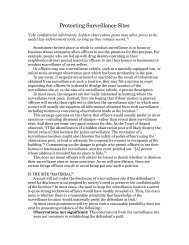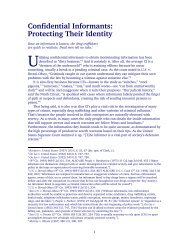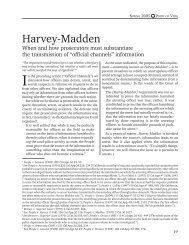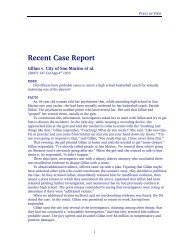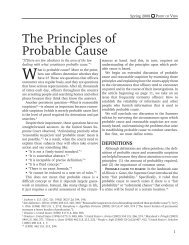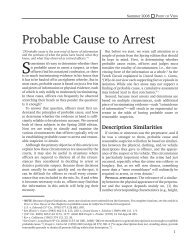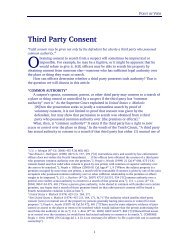Executing Search Warrants - Alameda County District Attorney's Office
Executing Search Warrants - Alameda County District Attorney's Office
Executing Search Warrants - Alameda County District Attorney's Office
You also want an ePaper? Increase the reach of your titles
YUMPU automatically turns print PDFs into web optimized ePapers that Google loves.
not demand any showing that such a belief be correct or more likely true than false. A<br />
practical, nontechnical probability that incriminating evidence is involved is all that is<br />
required.” 117<br />
As we will now discuss, this issue arises mainly when officers seize unlisted drugs,<br />
stolen property, or instrumentalities of a crime while they are executing a warrant to<br />
search for other things. It may also arise when they answer the suspect’s phone.<br />
DRUGS: Not surprisingly, illegal drugs top the list of unlisted evidence that is likely to<br />
be found. If, as is usually the case, the drugs were inside a container, probable cause will<br />
often be based on the nature of the container. 118 As the Court of Appeal explained,<br />
“Courts have recognized certain containers as distinctive drug carrying devices which<br />
may be seized upon observation: heroin balloons, paper bindles and marijuana smelling<br />
brick-shaped packages.” But the court also pointed out that “[o]ther common carriers,<br />
however, such as pill bottles, cigarette packs, plastic bags, film canisters are seen as more<br />
generic and may not be seized merely because they may be used to store narcotics.” 119<br />
[“(T)he required nexus is that between the item discovered and a criminal activity, though not<br />
necessarily the criminal activity denominated in the warrant.”].<br />
117 Texas v. Brown (1983) 460 US 730, 742. NOTE: In the past, the courts would say that evidence<br />
could not be seized unless there was a “nexus” or link between it and criminal activity. See People<br />
v. Superior Court (Meyers) (1979) 25 Cal.3d 67, 73. In 1987, however, the U.S. Supreme Court<br />
ruled that something more than a link is required: there must be probable cause to believe the<br />
item was evidence. Arizona v. Hicks (1987) 480 US 321, 326.<br />
118 See Texas v. Brown (1983) 460 US 730, 742-3 [knotted balloon]; Arkansas v. Sanders (1979)<br />
442 US 753, 764, fn.13; Henry v. United States (1959) 361 US 98, 104; People v. Chapman (1990)<br />
224 Cal.App.3d 253, 257 [“Probable cause to believe a container holds contraband may be<br />
adequately afforded by its shape, design, and the manner in which it is carried.”]; People v. Banks<br />
(1990) 217 Cal.App.3d 1358, 1364 [Zip-lock bags “are routinely used to carry rock cocaine.”];<br />
People v. Nonnette (1990) 221 Cal.App.3d 659, 666 [bundle of tiny baggies of the type used for<br />
drugs]; People v. Guajardo (1994) 23 Cal.App.4 th 1738, 1743, fn.3 [“Times have changed since<br />
1976 and we cannot in this day and age (at least in Los Angeles <strong>County</strong>) give serious consideration<br />
to the holding in People v. Knisely (1976) 64 Cal.App.3d 110, 117 that, in the absence of some<br />
evidence showing a cigarette pack is a common hiding place for narcotics, the fact that a small<br />
object is placed in the pack is not a suspicious circumstance.”]; People v. Arango (1993) 12<br />
Cal.App.4 th 450, 454-5; People v. Gonzales (1989) 216 Cal.App.3d 1185, 1191; People v. Fay (1986)<br />
184 Cal.App.3d 882, 893; People v. Rodrigues-Fernandez (1991) 235 Cal.App.3d 543, 547; People<br />
v. Ross (1968) 265 Cal.App.2d 195, 201, fn.2 [“Judicial notice may be taken that certain articles<br />
innocuous in themselves are part of the paraphernalia of narcotic users.”]; People v. Rodriquez<br />
(1969) 274 Cal.App.2d 770, 776 [“(I)t is common knowledge in police work that balloons or<br />
contraceptives are often used to carry narcotics because they can be swallowed to avoid<br />
detection.”]; People v. Clayton (1970) 13 Cal.App.3d 335, 337-8 [“It is now common knowledge<br />
among law enforcement officers, and trial counsel and judges, that small usable quantities of<br />
heroin are customarily carried in ‘bindles,’ small intricately folded papers aptly described by the<br />
police officer of our case as a ‘pharmaceutical paper.’”]; People v. Lilienthal (1978) 22 Cal.3d 891,<br />
898 [bindle]; United States v. Jacobsen (1984) 466 US 109, 121; People v. Ortiz (1995) 32<br />
Cal.App.4 th 286 290-1; U.S. v. Ayon-Meza (9 th Cir. 1999) 177 F.3d 1130, 1133 [court notes “duct<br />
tape covering was favored by drug dealers”]; People v. Smith (1981) 120 Cal.App.3d 282, 289;<br />
People v. Sotelo (1971) 18 Cal.App.3d 9, 17; People v. Poole (1975) 48 Cal.App.3d 881, 885-6;<br />
People v. McKinnon (1972) 7 Cal.3d 899, 917 [brick-shaped package smelling of marijuana];<br />
People v. Ortiz (1995) 32 Cal.App.4 th 286 290-1 [tinfoil bindles next to plastic, knife, and razor<br />
blade]; People v. Superior Court (Gilbert) (1981) 116 Cal.App.3d 450, 454 [bag “commonly used<br />
for illicit drugs hastily deposited under the hood of a car”; odor of PCP]; People v. Guy (1980) 107<br />
Cal.App.3d 593, 599, fn.4 [baggie containing white powder].<br />
119 People v. Holt (1989) 212 Cal.App.3d 1200, 1205.<br />
20



